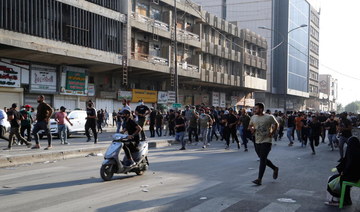RIYADH: Iraq’s prime minister was unhurt after an assassination attempt using a drone at his residence early Sunday.
Prime Minister Mustafa Al-Kadhimi said that he was fine in a recorded televised message after the incident, which injured seven members of his security detail.
Al-Kadhimi, who has been moved to a secure location, called for calm and restraint for the sake of Iraq, and backed security forces to ensure the safety of the nation and to uphold the law.
“Cowardly rocket and drone attacks don’t build homelands and don’t build a future,” he said in the brief TV address, sitting behind a desk in a white shirt, looking composed.
There was no immediate claim for the attack.
He said security forces were doing their part in tracking down the perpetrators of the attack, which involved a single drone, according to Al Arabiya, who also broadcast clips of what sounded like gunfire from Baghdad. But security officials told the Associated Press that there were two explosive-ladened drones used in the attack.
Later in the day, Kadhimi appeared in a video footage published by his office chairing a meeting with top security commanders to discuss the drone attack.
“The cowardly terrorist attack that targeted the home of the prime minister last night with the aim of assassinating him, is a serious targeting of the Iraqi state by criminal armed groups,” the premier’s office said in a statement issued following the meeting.
Residents of Baghdad said they heard gunfire and an explosion from the direction of the heavily fortified Green Zone, which houses the prime minister’s home as well as several diplomatic missions and government offices.
“We strongly condemn this apparent act of terrorism and are in close touch with the Iraqi security forces,” said Ned Price, US Sate Department spokesperson. “Our commitment to our Iraqi partners is unshakeable.”
Al-Kadhimi on Friday ordered the formation of a committee to investigate clashes between Iraqi security forces and supporters of parties that are disputing the results of a general election in October.
One protester was killed and around 100 injured after hundreds of pro-Iran Hashed Al-Shaabi supporters rallied in Baghdad near the Green Zone throwing projectiles and blocking access before being dispersed by security forces.
Pro-Iran groups said that live rounds were used against protesters, but the health ministry denied the claims.
Voters turned their backs on the previously powerful Fatah Alliance, reducing their number of seats in parliament from 48 to no more than 14.
The alliance comprises candidates from Hashed Al-Shaabi, who finished second in the last elections in 2018 in what was viewed as evidence of Tehran’s growing influence.
That triggered a backlash in October 2019, when hundreds of thousands of Iraqis took to the streets in “Tishreen” protests against corruption, unemployment and foreign influence. Security forces and the Hashed Al-Shaabi militia killed about 600 in a violent crackdown.
























